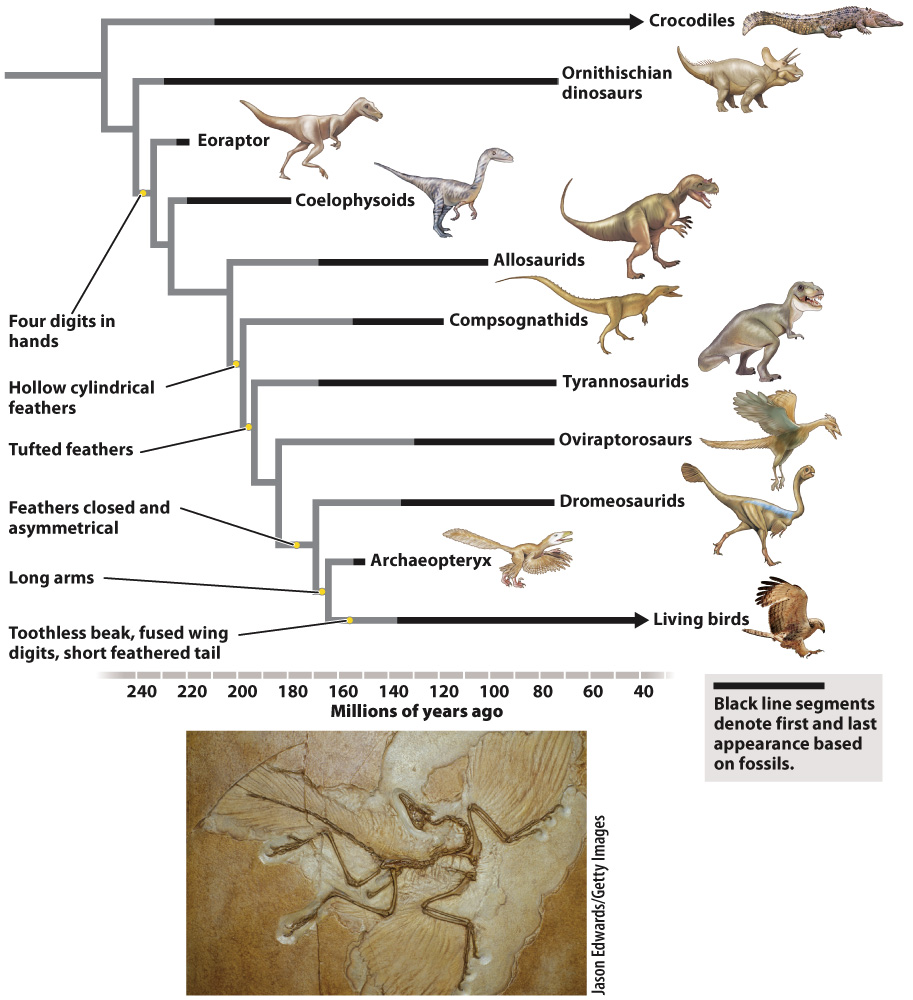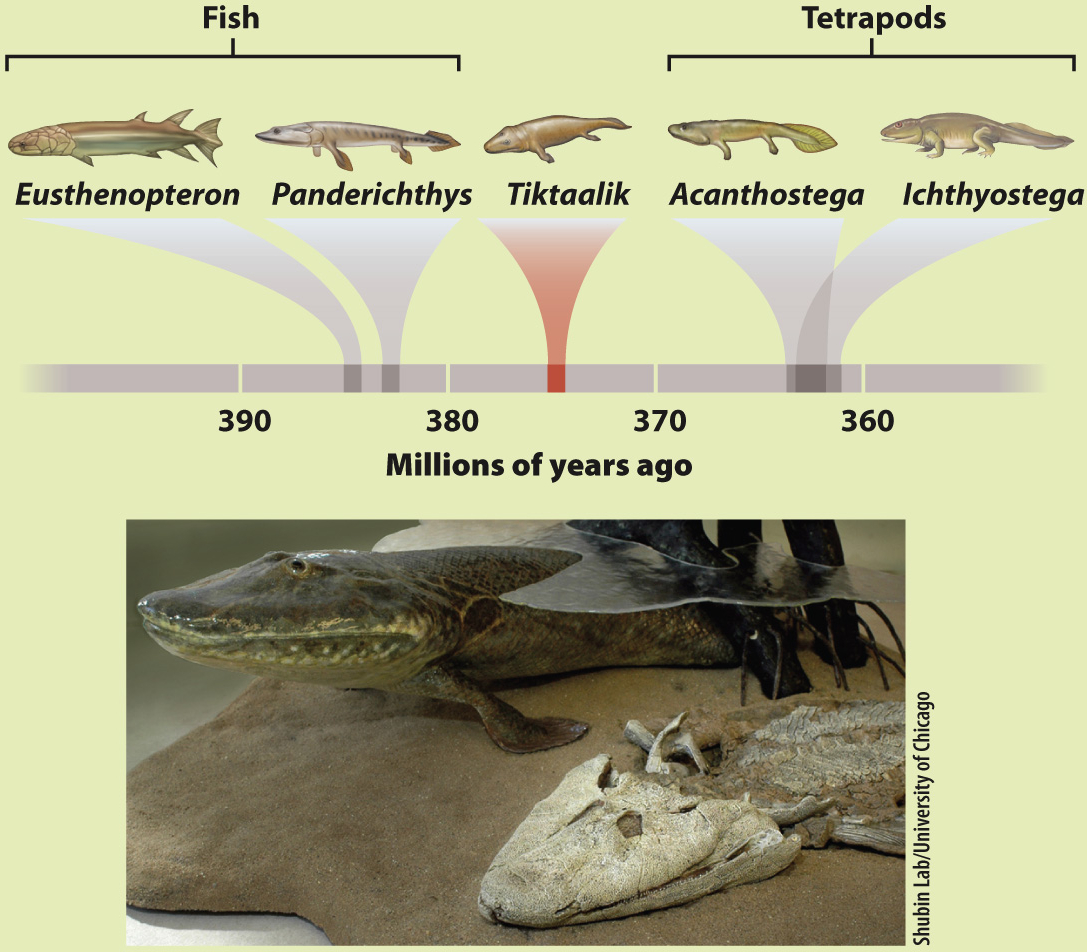Fossils can contain unique combinations of characters.
Phylogenies hypothesize impressive morphological and physiological shifts through time—amphibians from fish, for example, or land plants from green algae. Do fossils capture a record of these transitions as they took place?
Let’s begin with an example introduced earlier in this chapter. Phylogenies based on living organisms generally place birds as the sister group to crocodiles and alligators, but birds and crocodiles are decidedly different from each other in structure—birds have wings, feathers, toothless bills, and a number of other skeletal features distinct from those of crocodiles. In 1861, just two years after publication of On the Origin of Species, German quarry workers discovered a remarkable fossil that remains paleontology’s most famous example of a transitional form. Archaeopteryx lithographica, now known from 11 specimens splayed for all time in fine-grained limestone, lived 150 million years ago. Its skeleton shares many characters with dromaeosaurs, a group of small, agile dinosaurs, but several features—its pelvis, its braincase, and, especially, its winglike forearms—are distinctly birdlike. Spectacularly, the fossils preserve evidence of feathers. Archaeopteryx clearly suggests a close relationship between birds and dinosaurs, and phylogenetic reconstructions that include information from fossils show that many of the characters found today in birds accumulated through time in their dinosaur ancestors. As noted earlier, even feathers first evolved in dinosaurs (Fig. 23.19).

FIG. 23.19 Dinosaurs and birds. A number of dinosaur fossils link birds phylogenetically to their closest living relatives, the crocodiles. The fossil at the bottom is Archaeopteryx. Data from C. Zimmer, 2009, The Tangled Bank, Greenwood Village, CO: Roberts and Company.
Data from C. Zimmer, 2009, The Tangled Bank, Greenwood Village, CO: Roberts and Company; (photo) Jason Edwards/Getty Images.
Tiktaalik roseae and other skeletons in rocks deposited 375 to 362 million years ago record an earlier but equally fundamental transition: the colonization of land by vertebrates. Phylogenies show that all land vertebrates, from amphibians to mammals, are descended from fish. As seen in Fig. 23.20, Tiktaalik had fins, gills, and scales like other fish of its day, but its skull was flattened, more like that of a crocodile than a fish, and it had a functional neck and ribs that could support its body—features today found only in tetrapods. Along with other fossils, Tiktaalik captures key moments in the evolutionary transition from water to land, confirming the predictions of phylogeny.
Quick Check 4 You have just found a novel vertebrate skeleton in 200-million-year-old rocks. How would you integrate this new fossil species into the phylogenetic tree depicted in Fig. 23.7?
Quick Check 4 Answer
Character traits can be measured for fossils as well as living organisms, so you can examine the features of the skeleton and then construct a phylogenetic tree that takes into account the skeletal traits shared with known vertebrates.
HOW DO WE KNOW?
Can fossils bridge the evolutionary gap between fish and tetrapod vertebrates?
BACKGROUND Phylogenies based on both morphological and molecular characters indicate that fish are the closest relatives of four-legged land vertebrates.
HYPOTHESIS Land vertebrates evolved from fish by modifications of the skeleton and internal organs that made it possible for them to live on land.
OBSERVATION Fossil skeletons 390 to 360 million years old show a mix of features seen in living fish and amphibians. Older fossils have fins, fishlike heads, and gills, and younger fossils have weight-bearing legs, skulls with jaws able to grab prey, and ribs that help ventilate lungs. Paleontologists predicted that key intermediate fossils would be preserved in 380–370-million-year-old rocks. In 2004, Edward Daeschler, Neil Shubin, and Farish Jenkins discovered Tiktaalik, a remarkable fossil that has fins, scales, and gills like fish, but wrist bones and fingers, an amphibian-like skull, and a true neck (which fish lack).

FIG. 23.20
CONCLUSION Fossils confirm the phylogenetic prediction that tetrapod vertebrates evolved from fish by the developmental modification of limbs, skulls, and other features.
FOLLOW-UP WORK Research into the genetics of vertebrate development shows that the limbs of fish and amphibians are shaped by similar patterns of gene expression, providing further support for the phylogenetic connection between the two groups.
SOURCE Daeschler, E. B., N. H. Shubin, and F. A. Jenkins, Jr. 2006. “A Devonian Tetrapod-like Fish and the Evolution of the Tetrapod Body Plan.” Nature 440:757–763.

